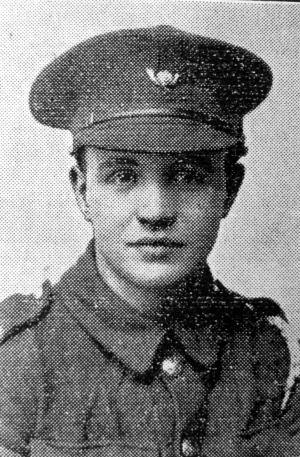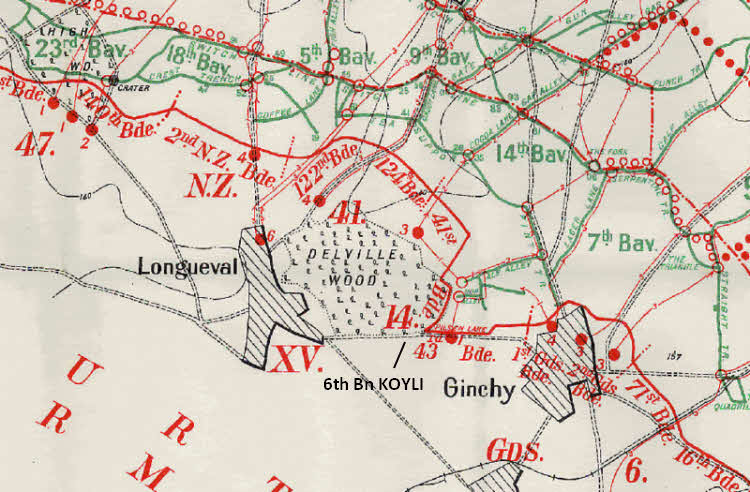
Robert Clarkson was born in Bretton, Wakefield in late 1895, the only son of Albert Henry Clarkson and his wife Agnes (nee Farrar), who had married in 1889 in the Dewsbury registration district. The Clarksons lived at 2, Intake Lane, Ossett and in 1911, Robert’s father Albert worked as a labourer, whilst Robert worked as mule piecener in a mungo mill.
Robert Clarkson had enlisted with the King’s Own Yorkshire Light Infantry at Ossett in October 1915 and went to France in 1916, landing in Boulogne on the 21st May. Private Clarkson was awarded the Victory and British medals posthumously.
The “Ossett Observer” 1 gave this account of Robert’s death: “Official intimation was received on Monday morning that Private Robert Clarkson of the King’s Own Yorkshire Light Infantry, whose parents reside at the top of Intake Lane, Ossett was killed in action on September 15th. The young soldier, who was twenty years of age, had been missing since the date named. Several weeks ago, a comrade reported that he had seen the deceased fall in battle. At the time he joined the army, about October last year, Private Clarkson worked at Bottomfield Mill. He went out to the front in May. Since within a week or two of the outbreak of the war, the deceased’s father, Albert Clarkson, has been serving as an ambulance man, being attached to the Naval Sick Berth Reserve at an ambulance station in Kent.”
He was killed in action, serving with the 6th (Service) Battalion of KOYLI at the Battle of Flers-Courcelette on the 15th September 1916. The Battle of Flers-Courcelette, 15th – 22nd September 1916, was the third main phase of the Battle of the Somme. It is best known as the first tank battle in history, as it featured forty nine Mk I tanks (although not all of the tanks made it into battle). On the right of the line XIV Corps did not have a successful day. The 56th Division was to form the right flank of the attack, buts its attack soon bogged down. To their left the 6th Division needed to overcome a strong German position known as the Quadrilateral, north of Leuze Wood, before it could attack its first objective for the day. Despite some bitter fighting, little progress was made.

Above: Map showing the position of the 6th Battalion, KOYLI on the 15th September 1916 at Delville Wood, the scene of bitter fighting in the Battle of Flers-Courcelette where Private Robert Clarkson was killed in action.
To the right XV Corps was much more successful, but failed to achieve the hoped for breakthrough. Their attack was supported by fourteen tanks (four more were allocated to the corps but were unable to take part in the attack). The 14th Division had to begin the day early, to clear the Germans out of a pocket east of Delville Wood, where they still held on to a forward position. This attack was carried out by two companies (W and X) of the 6th Battalion, King’s Own Yorkshire Light Infantry (KOYLI) supported by three tanks and they were ordered to expel the Germans prior to the main attack. Only one tank (D1) was operational and it advanced from Pilsen Lane followed by the KOYLI’s bombers.
The infantry attack went in at 5.20 a.m. with tank D1 passing through the waiting infantry and crossing No Man’s Land, towards the German positions. As it reached the edge of Delville Wood, where it joined Hop Alley, it fired its 6lb guns into the wood. It then turned east, driving parallel to the Hop Alley trench; two infantry companies from the 6th Battalion KOYLI emerged from the wood and followed D1 to join in the attack. D1 then turned north at the junction with Beer Trench and followed Ale Alley, clearing the remaining German defenders and firing at the enemy as they fled to the north east. D1 advanced too quickly to the north, however, and strayed into the British creeping barrage, where a shell put the tank out of action!
The infantry from the 6th Battalion KOYLI came under machine gun fire from their flank after crossing Ale Alley. Every single one of the KOYLI officers was lost, but what remained of the two companies under their NCOs turned back and with bomb and bayonet, dealt with their attackers. They later advanced and then took part in the main offensive.2
Despite the view of many authors who have written about Flers-Courcelette, who consider it as being a battle with relatively few casualties in view of the gains that had been achieved. Thousands of men on both sides had been killed, or wounded; many had simply ‘vanished’, blown to pieces in an instant by shellfire.
Above: Infantry moves off with armour for the first time in history in what would become known as the Battle of Flers-Courcelette. Notice the awkward steering aid wheels attached to the rear of the Mark I tank. The cage on top was to prevent grenades from being tossed on top of the tank.
Private Robert Clarkson is remembered at the Thiepval Memorial, Somme , France on Pier and Face 11 C and 12 A. The Memorial to the Missing of the Somme, bears the names of more than 72,000 officers and men of the United Kingdom and South African forces who died in the Somme sector before 20 March 1918 and have no known grave. Over 90% of those commemorated died between July and November 19163.
References:
1. “Ossett Observer” 21st October 1916
2. Battle of Flers-Courcelette, 15th-22nd September 1916